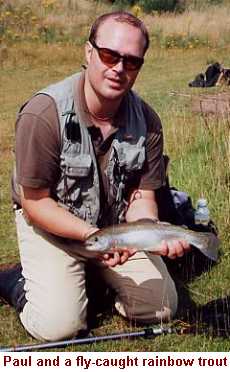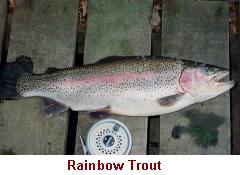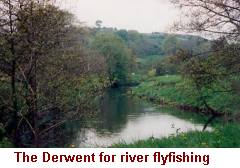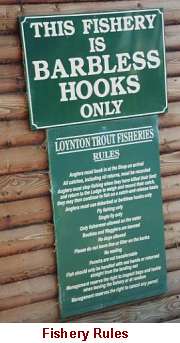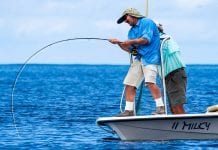Part 1 – IntroductionFor many years the sport of flyfishing was seen as only for the wealthy. It was always regarded as the ‘posh’ type of fishing, which took place on private waters by the aristocracy and upper classes. However, like many so called ‘status sports’ such as golf and tennis, flyfishing has now reached ‘us’ lower classes and can be enjoyed by all! Many people avoid this side of our wonderful sport as they think that it is expensive and includes complicated casting techniques. Over the next few minutes you will read that it is neither of the above. I am not rich, not the most technically minded angler, and I’m certainly not ‘upper class’! However, I must also say that I am no top expert on flyfishing; I just want to encourage some of you to try flyfishing and to explain a few of the starting out tips and basics so often missed by some flyfishing writers. I started flyfishing back in the ‘good old days’ when the fishing calendar still had the universal close season for coarse fish. After I had packed away the match rods and reels (usually ‘chucked’ in the corner of the garage!) I would dust down the fly rods and head towards Ladybower Reservoir near Sheffield. It was a great way to bridge the season and very enjoyable as well (although, I must admit I don’t miss the early season sleet and snow which I used to endure at Ladybower). > Then, being a lover of coarse fishing, I would put the fly gear away in early June ready for the glorious 16th when I would be back down the Trent with my stick float rod. However, over the past few years I have begun to fish for trout all year round, and I have learnt so much by keeping the fly rod out and how enjoyable and accessible flyfishing can be. The Quarry Trout belong to the salmonid family and most common types you will come across are rainbow and brown trout. However in some fisheries, certain variations have been introduced such as American brook trout, tiger trout and even golden trout. Rainbow Trout The main characteristics of a rainbow trout are a silver body with a fantastic pinkish zone along its lateral line. Brown Trout So now you know a little more about the fish we are after, and how to identify them, we can now think about the ‘how’ and ‘where’ of catching them. The first thing to think about is ‘where’, as so many anglers make the easy mistake of buying gear before thinking about where they are going to fish. It is pointless spending your hard-earned money on tackle which is not suitable for the type of water you are going to fish. Types of fisheries 1) Rivers – These may be a little harder to locate or to obtain fishing rights as they mainly belong to private clubs and syndicates. However, if you do a little homework and ask around you may find some running water in your area which is fishable on a day ticket basis. The rivers follow the traditional close season for trout; closed 15th November to 16th May inclusive for rainbow trout and 16th October to 17th March for brown trout. The fish in these waters are fighting fit as they live in moving water, fighting against the current. Therefore if you do get a chance to fish a river then ‘go for it’ as they can give great sport. However, as river banks can be overgrown, especially in summer, you may need to feel confident in your casting techniques if you are going to avoid catching more trees and bushes than fish! You may be better in the first instance trying stillwaters before moving on to the rivers. 2) Lakes & Pools – These are a great place to start as most are tailored to the fly fisherman with open casting areas and lots of catchable fish. These fisheries vary in size and are spread all over the country, so you should have one close to your home. The trout are stocked on a regular basis and the fish size will vary from 1lbs up to 20lbs-plus on some waters. Fishing is usually offered on a day-ticket basis with most of the waters open for year-round fishing and most will offer on-site casting tuition. 3) Reservoirs – These are the large expanses of water which tend to be owned and run by the local water authority who supply the water for your weekly bath! They are generally stocked on a regular basis and the fishing is offered on a day or season-ticket basis from a boat or bank. Some have on-site trout farms, whilst others have the fish transported in from fish farms. Most reservoirs offer fishing between March/April up to November each year. It goes without saying that because of the size of some of these reservoirs it is not always possible to find the fish on your first attempt. So talking to other anglers and spending some time before fishing watching the water can help put you on the fish. Whilst reservoir fishing can give you some big fish, you may need to dedicate some time to a venue before you really see the results. Once you have decided the type of fishery you want to try, locating the waters near to you can be done by visiting your local fishing tackle shop or by looking in the angling press. Trout Fisherman magazine gives a monthly fishing report on most trout waters including the telephone numbers, fishing tips and it is sectioned into regions to help you find the waters in your neck of the woods. Tickets/Permits There are different types of day tickets. A typical fishery ticket list could be as follows – This is just an example, but it shows how you can chose the length of your session to fit in with the amount of time you have available or to match your budget. At some fisheries it is now possible to purchase a ‘catch and release’ ticket. This allows you to use barbless hooks, carefully handle the fish and to enjoy the sport before returning the trout for another day. This is a contentious issue at present with many anglers speaking out against this method. However, personally speaking, I often wonder how many trout are killed (because it is the rules), frozen and then chucked in the dustbin during your annual freezer clear-out. Why not handle them carefully and then put them back for another day and another angler? One of the most important parts of your fishing trip will be to fill in the catch return before you trundle off home to show the missus your catch. By informing the fishery owner/manager of the amount and weight of the trout you have killed and returned they can ensure that a correct amount of fish are stocked to maintain the fishing potential. Many fisheries offer a monthly or annual prize draw for returns and also a ‘fish of the month’ prize – so make sure that you fill that form in! |
Welcome!Log into your account










